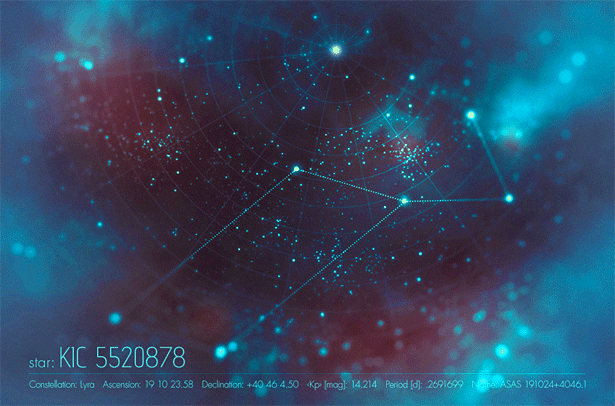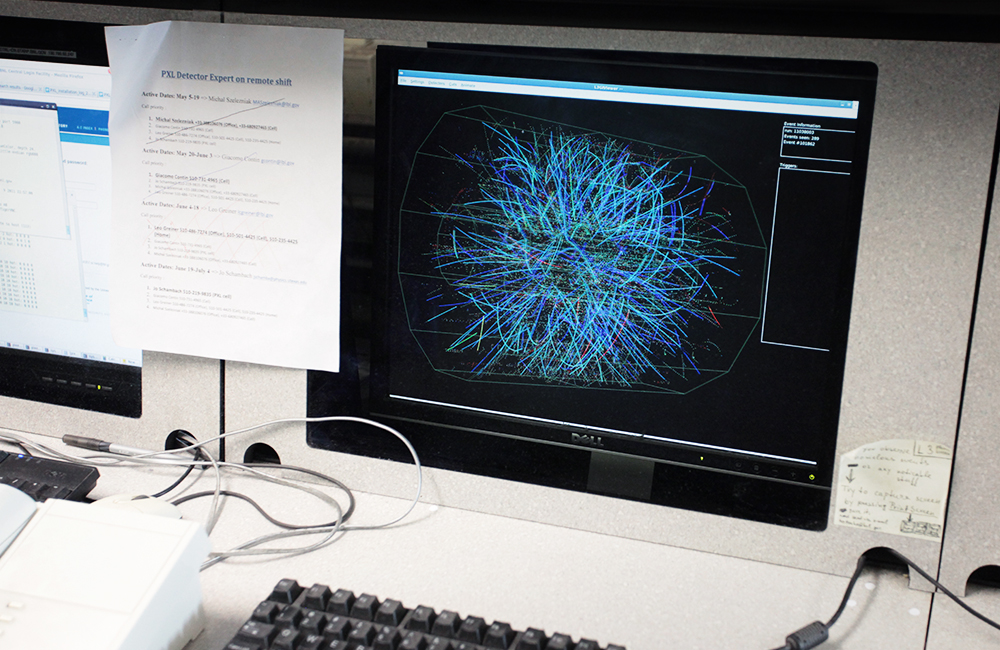Strange Stars Pulse to the Golden Mean
What struck John Learned about the blinking of KIC 5520878, a bluish-white star 16,000 light-years away, was how artificial it seemed.
Learned, a neutrino physicist at the University of Hawaii, Mānoa, has a pet theory that super-advanced alien civilizations might send messages by tickling stars with neutrino beams, eliciting Morse code-like pulses. “It’s the sort of thing tenured senior professors can get away with,” he said. The pulsations of KIC 5520878, recorded recently by NASA’s Kepler telescope, suggested that the star might be so employed.
A “variable” star, KIC 5520878 brightens and dims in a six-hour cycle, seesawing between cool-and-clear and hot-and-opaque. Overlaying this rhythm is a second, subtler variation of unknown origin; this frequency interplays with the first to make some of the star’s pulses brighter than others. In the fluctuations, Learned had identified interesting and, he thought, possibly intelligent sequences, such as prime numbers (which have been floated as a conceivable basis of extraterrestrial communication). He then found hints that the star’s pulses were chaotic.
But when Learned mentioned his investigations to a colleague, William Ditto, last summer, Ditto was struck by the ratio of the two frequencies driving the star’s pulsations.
“I said, ‘Wait a minute, that’s the golden mean.’”
This irrational number, which begins 1.618, is found in certain spirals, golden rectangles and now the relative speeds of two mysterious stellar processes. It meant that the blinking of KIC 5520878 wasn’t an extraterrestrial signal, Ditto realized, but something else that had never before been found in nature: a mathematical curiosity caught halfway between order and chaos called a “strange nonchaotic attractor.”
Dynamical systems — such as pendulums, the weather and variable stars — tend to fall into circumscribed patterns of behavior that are a subset of all the ways they could possibly behave. A pendulum wants to swing from side to side, for example, and the weather stays within a general realm of possibility (it will never be zero degrees in summer). Plotting these patterns creates a shape called an “attractor.”
Mathematicians in the 1970s used attractors to model the behavior of chaotic systems like the weather, and they found that the future path of such a system through its attractor is extremely dependent on its exact starting point. This sensitivity to initial conditions, known as the butterfly effect, makes the behavior of chaotic systems unpredictable; you can’t tell the forecast very far in advance if the flap of a butterfly’s wings today can make the difference, two weeks from now, between sunshine and a hurricane. The infinitely detailed paths that most chaotic systems take through their attractors are called “fractals.” Zoom in on a fractal, and new variations keep appearing, just as new outcrops appear whenever you zoom in on the craggy coastline of Great Britain. Attractors with this fractal structure are called “strange attractors.”
Then in 1984, mathematicians led by Celso Grebogi, Edward Ott and James Yorke of the University of Maryland in College Park discovered an unexpected new category of objects — strange attractors shaped not by chaos but by irrationality. These shapes formed from the paths of a system driven at two frequencies with no common multiple — that is, frequencies whose ratio was an irrational number, like pi or the golden mean. Unlike other strange attractors, these special “nonchaotic” ones did not exhibit a butterfly effect; a small change to a system’s initial state had a proportionally small effect on its resulting fractal journey through its attractor, making its evolution relatively stable and predictable.
“It was quite surprising to find these fractal structures in something that was totally nonchaotic,” said Grebogi, a Brazilian chaos theorist who is now a professor at the University of Aberdeen in Scotland.
Though no example could be positively identified, scientists speculated that strange nonchaotic attractors might be everywhere around and within us. It seemed possible that the climate, with its variable yet stable patterns, could be such a system. The human brain might be another.
The first laboratory demonstration of strange nonchaotic dynamics occurred in 1990, spearheaded by Ott and none other than William Ditto. Working at the Naval Surface Warfare Center in Silver Spring, Maryland, Ditto, Ott and several collaborators induced a magnetic field inside a metallic strip of tinsel called a “magnetoelastic ribbon” and varied the field’s strength at two different frequencies related by the golden ratio. The ribbon stiffened and relaxed in a strange nonchaotic pattern, bringing to life the mathematical discovery from six years earlier. “We were the first people to see this thing; we were pleased with that,” Ditto said. “Then I forgot about it for 20 years.”
In a very different field of academia, astronomers since ancient times have contemplated stars that throb. In 1912, Henrietta Leavitt discovered that the frequency at which variable stars pulsate corresponds to their intrinsic brightness, a feature that later allowed them to be used as “standard candles” for gauging cosmic distances. The conventional explanation for the stars’ behavior comes from Sir Arthur Eddington, who proposed in the 1930s that variable stars grow and shrink in a continual cycle: First, a star shines brightly, but as it gradually shrinks and heats up, its outer layer turns opaque, dimming the starlight. As the energy trapped inside the star builds up, the star expands under the pressure, cools, becomes transparent, and shines brightly once again.
The study of variable stars entered boom times in 2009 with the launch of the Kepler telescope, which looked for small aberrations in starlight as a sign of distant planets. The telescope gathered a trove of unprecedented data on the pulsations of variable stars throughout the galaxy. Other, ground-based surveys have added further riches.
The data revealed subtle variations in many of the stars’ pulsations that hinted at stellar processes beyond those described by Eddington. The pulses of starlight could be separated into two main frequencies: a faster one like the beat of a snare drum and a slower one like a gong, with the two rhythms played out of sync. And in more than 100 of these variable stars — including those, like KIC 5520878, belonging to a subclass called “RRc” — the ratios defining the duration of one frequency relative to the other inexplicably fell between 1.58 and 1.64.
“This is an entirely new ratio, and we don’t know what it’s about,” said Katrien Kolenberg, a variable star specialist with joint appointments at the Harvard-Smithsonian Center for Astrophysics and two universities in Belgium.
Within this window lies the golden mean. Upon seeing the number last summer, Ditto instantly suspected that KIC 5520878 and stars like it might be exhibiting strange nonchaotic dynamics. Indeed, when he and his co-authors tracked the brightness of the stars over time, they found signs of fractal yet nonchaotic variation in all four of the RRc stars in the Kepler data set, KIC 5520878 among them.
As the star’s brightness waxes and wanes through time, it appears to wend a fractal path around and around a doughnut-shaped attractor. Zoom in or out, and the path looks similarly erratic at every scale of resolution. Like a craggy coastline, the peaks in the star’s brightness are variegated by smaller peaks occurring on shorter time scales, and those peaks are studded with even smaller and quicker peaks. But because the star is nonchaotic, there is no butterfly effect; paths that converge stay correlated. Imagine you are the star moving around its attractor. “You drop a bread crumb in a spot every half-hour,” Ditto said. “Two years later I come to that spot and start dropping bread crumbs. I fundamentally come back to your bread crumbs every few hours or days, no matter what I do. It’s crazy. Any two [nearby] points on the doughnut behave like that.”
The discovery, reported in February in Physical Review Letters, has some astronomers turning to arcane mathematics papers for new clues about the inner workings of variable stars.
“It’s really interesting because it’s a new kind of dynamical behavior,” said Róbert Szabó, a variable-star expert at Konkoly Observatory in Budapest, Hungary. “But it might be only a coincidence,” unrelated to the fundamental physics at work in the stars. Adding to the mystery are the hundreds of other variable stars that are also driven through their attractor by two frequencies whose ratio is near the golden mean, though not always near enough to give rise to such special dynamical behavior.
“All this begs the question,” Ditto said, “what is fundamentally going on with these stars that they end up with a ratio near the golden mean?”
The new paper offers one hypothesis. The KAM theorem, named for Andrey Kolmogorov, Vladimir Arnold and Jürgen Moser, holds that systems driven by frequencies in an irrational ratio tend to be the most stable; that is, they can’t easily be knocked off-kilter into a new state of motion. In that case, it might be the fate of unstable stars to evolve until they arrive at a number like the golden mean. “It’s the most robust number to perturbations, which means these stars may select it out,” Ditto explained.
Variable star specialists plan to develop new stellar physics models that incorporate the newfound secondary frequencies. This will allow them to examine the frequencies’ possible physical origins and the relevance of the KAM theorem. “If we have a good model, we can start to see what’s going on,” Szabó said, “what kind of pulsations and oscillations can be excited in these stars.”
As for Learned, who reported with his colleagues in The Astrophysical Journal that the blinking of KIC 5520878 is almost definitely natural after all, the events of the past year are a prime example of “science in action,” he said. “We started out looking for something kind of wacky, and we found something that may turn out to be of big importance in understanding stellar dynamics.”
Correction on March 11, 2015: An earlier version of this article asserted that the golden ratio is found in nautilus shells, which is a common misperception. Nautilus shells are closer to the ratio 4/3, or 1.33.
This article was reprinted on BusinessInsider.com.




